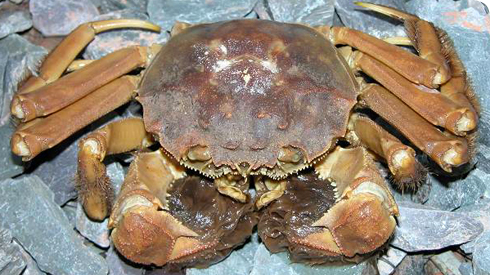Eriocheir sinensis (Chinese mitten crab)
The Chinese mitten crab, Eriocheir sinensis, has been widely introduced into many regions outside of its native range in China. As a result, it has been placed on the International Union for Conservation of Nature's (IUCN) list of the world's worst 100 invasive alien species.
It has conspicuous setal mats on its claws and both its British common name, Chinese mitten crab, and its scientific name, Eriocheir sinensis, which means ‘wool hand, the Chinese’, originate from this distinguishing feature. It is the only crab in Britain that has this.
Species detail
As an alien species the mitten crab has the potential to upset existing ecosystems and cause a variety of problems by
- competing with and preying on native species
- damaging riverbanks
It can also disrupt fishing operations, as it has sharp claws that can destroy nets and damage fish caught within them.
Museum scientists are involved in research to assess whether alien populations of the crab could be controlled by commercial exploitation. In particular, they have addressed whether the crabs in the River Thames in London are safe to eat and whether they could be fished commercially. Their results were announced in February 2009.
-

Taxonomy
Learn about the taxonomy of Eriocheir sinensis and related species.
-

Life history and migration behaviour
Mitten crabs are catadromous. That is, they spend most of their life in freshwater, but must return to higher salinities to breed. Learn more about their life history and migration behaviour.
-

Distribution
Get information about the native range of Eriocheir sinensis and learn about its spread around the world, including its introduction into Britain and Europe.
-

Ecology
Find out about the habitat preferences of mitten crabs and what they feed on.
-

Associations
Eriocheir sinensis is a host of the lung fluke Paragonimus westermani which causes the disease paragonimiasis if passed on to humans. Find out more, including the results of an analysis of mitten crabs in the River Thames.
-

Management
If this invasive species isn't managed effectively, populations could cause irreparable damage to native ecosystems and spread even further. Find out the results of Museum scientists' research into whether a commercial fishery could be used to reduce the number of mitten crabs in the River Thames and what the next step is.
-

References
Get reference information for the Chinese mitten crab, Eriocheir sinensis.
Images

The Chinese mitten crab, Eriocheir sinensis, can grow to a large size. The width of its carapace often exceeds 84mm and, taking its legs into account, it can be as big as a dinner plate. © Aquatonics Ltd
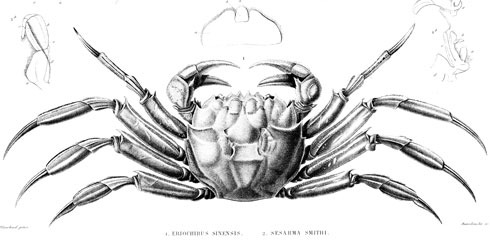
Illustration of Eriocheir sinensis that accompanied the 1854 description by H. Milne Edwards in the Archives du Muséum d'Histoire Naturelle.

An egg-bearing female mitten crab from the River Thames in London, with around a million eggs attached to her underside.
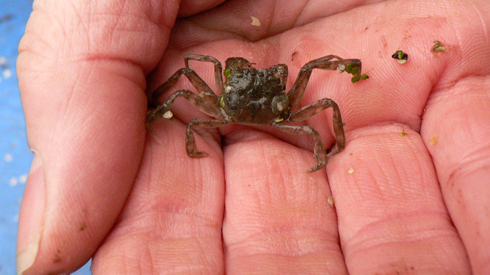
A juvenille mitten crab in the palm of someone's hand.

Mitten crab burrows in the unprotected river bank of Syon Park flood meadow in London, photographed in November 2005.

Photographed in November 2005, this reed bed on the southern bank of Chiswick Eyot in the River Thames, London, is peppered with probable mitten crab burrows. The remnants of the collapsing bank can be seen on the beach in the foreground.
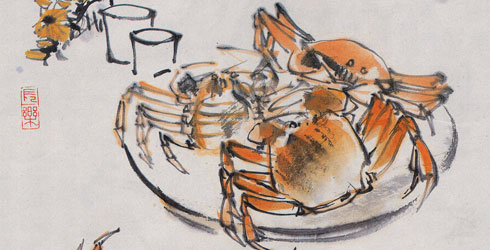
Eriocheir sinensis is considered to be a delicacy in many countries in east Asia and is a relatively common subject depicted in Chinese art. Here the crabs are shown piled up on a plate. © Jiangsu Fine Arts Publishing House

The ovaries and testes of mitten crabs are considered to be a delicacy in southeast Asia. Consequently mitten crabs are a seasonal product, consumed during the autumn migration period when the gonads are ripening.
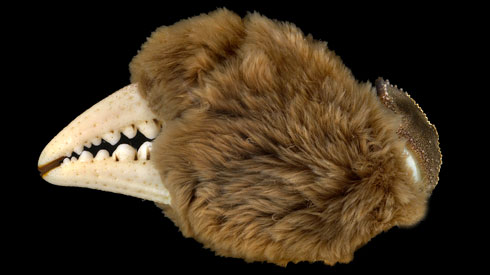
The left claw of a male mitten crab (Eriocheir sinensis). Both the common name and scientific name of this species originate from the distinctive appearance of its claws.
Video of adult crabs
Watch a video showing the collection of live adult mitten crabs from the River Thames in London.
You need to download the latest Flash Player to view this video. Visit the website to download the Flash Player
Video of young crabs
Watch a video showing the collection of juvenille mitten crabs collected from under a rock on the banks of the River Thames in London.
You need to download the latest Flash Player to view this video. Visit the website to download the Flash Player
About the author

Dr Paul Clark
Crustacean researcher focusing on invasive Chinese mitten crabs, brachyuran larvae and the phylogeny of xanthoids.
Glossary
Setal mat
A mass of setae, which are filamentous projections that appear similar to stiff hairs or bristles.
